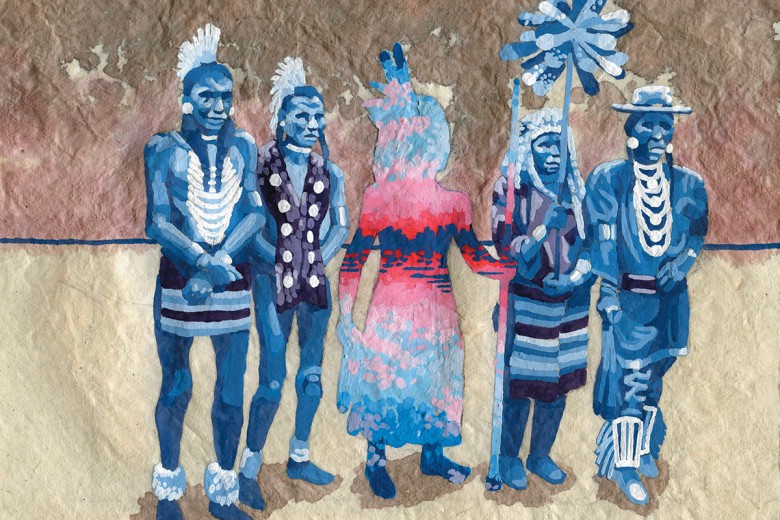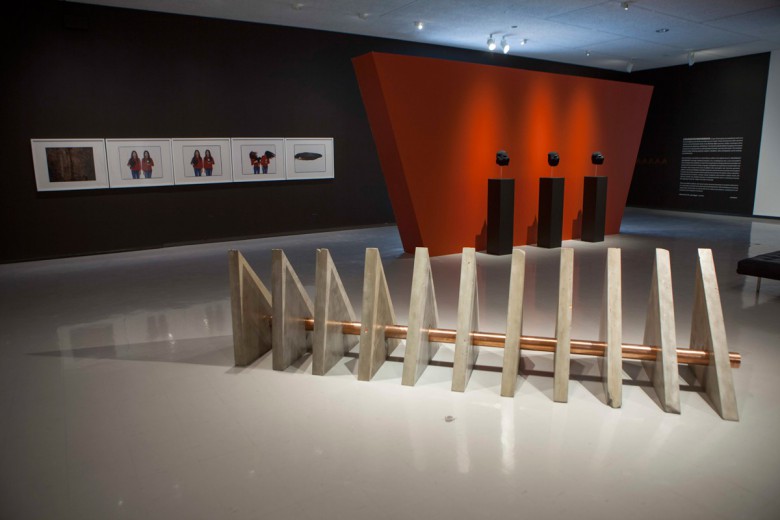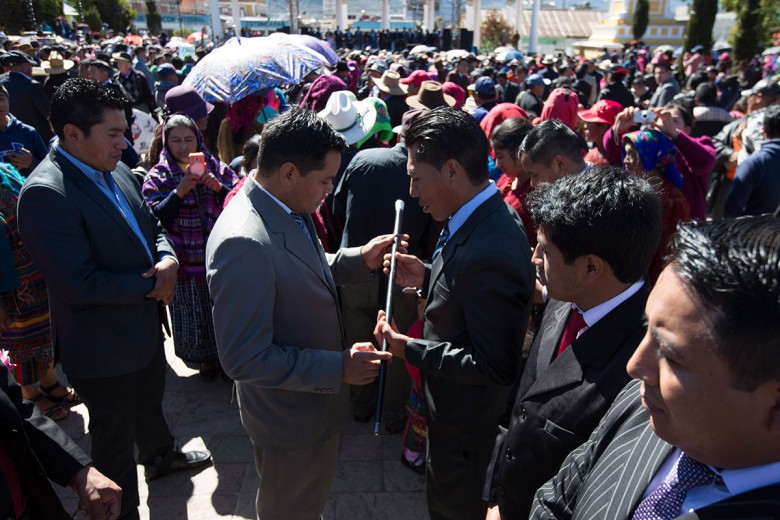By Ward Churchill
June/July 2008
Responding to the Canadian government’s establishment of an Indian Residential Schools Truth and Reconciliation Commission, Churchill argues for the need to situate the formation of this commission within the broader history of indigenous/settler relations in North America, and within a legal understanding of the crime of genocide.
“Residential Schools were one of many attempts at the genocide of the Aboriginal Peoples inhabiting the area now commonly called Canada. Initially, the goal of obliterating these peoples was connected with stealing what they owned (the land, the sky, the waters, and their lives, and all that these encompassed)… . A variety of rationalizations (social, legal, religious, political, and economic) arose to engage (in one way or another) all segments of Eurocanadian society in the task of genocide. For example, some were told (and told themselves) that their actions arose out of a Missionary Imperative to bring the benefits of the One True Belief to savage pagans; others considered themselves justified in land theft by declaring that the Aboriginal Peoples were not putting the land to “proper” use; and so on. The creation of the Indian Residential Schools followed a time-tested method of obliterating indigenous cultures, and the psychosocial consequences these schools would have on Aboriginal Peoples were well understood at the time of their formation.”
Roland Chrisjohn, Sherri Young and Michael Maraun, The Circle Game: Shadows and Substance in the Indian Residential School Experience in Canada, Theytus Books Ltd, Penticton, 1997.
Truth is one thing, and reconciliation is something else entirely. The two terms have somehow become fused, however, to the point where they usually come out as just one word: truthandreconciliation. Kind of like some other fusions that I’ve encountered in my life — innocentamericans, for example. I had thought innocent was a qualification that had to be earned, and you didn’t just have it by virtue of some national identity. It’s nonsensical, and I would suggest that truthandreconciliation might be as well.
You see, were the truth to be expressed, internalized and acted upon, there might be a basis for reconciliation. People and communities can indeed reconcile within and among themselves, but that process is fundamentally different from the sort of superficial blather of the dominant society which is the primary promoter of the truthandreconciliation process in Canada, especially with regard to the ongoing effects of the system of residential schooling imposed for well over a century upon First Nations children.
Apologies mean little if we do not address the fundamental wrong that has occurred-in this case, colonialism and genocide. I had a formative experience with this idea that might help to illustrate this point. In 1993 I was asked to serve on a tribunal on the rights of indigenous Hawaiians-or Kanaka Maoli, as they call themselves. Their rightful territory is the entire Hawaiian archipelago.
In 1993, the U.S. Congress voted overwhelmingly to issue an apology to the Kanaka Maoli for having overthrown the Hawaiian monarchy and annexed the archipelago a hundred years earlier. Bill Clinton signed the proclamation on the hundredth anniversary of the overthrow. We’re sorry, Clinton said.
Both parties now agree that the U.S. acquired the islands by way of a series of illegal acts, but the government took no action beyond saying they were sorry. Despite admitting their breach of international law, there was no redress. There was no restitution of the islands to the Kanaka Maoli. No reparation for the massive environmental devastation at the hands of the U.S. during the period of its illegal occupation. No compensation to the Kanaka Maoli, not only for whatever land has been literally destroyed, but for the individual and collective pain, anguish, and other suffering they’ve been forced to endure ever since the U.S. usurped their sovereignty.
The reality behind all the conservative rhetoric about law and order is that the U.S. government was not in the least inclined to obey the law themselves, at least not when obeying the law might interfere with the interests of powerful groups of settlers. Knowing this history should give us all cause to view with great suspicion the Canadian government’s attempts to reconcile with the history of residential schools.
*
If it’s “truth and reconciliation” we’re after with regard to the residential schools, then the first truth we need to establish is that the Indian Residential Schools were not the result of a “misguided policy undertaken with the best of humanitarian intentions,” as they’re often described, but rather a pillar in the attempted genocide of Canada’s indigenous peoples.
This truth is masked, hidden, denied. It’s the official posture of the government of Canada that the word genocide will not be used in connection with the residential school truthandreconciliation process. But genocide is exactly what it was, and until that truth is recognized, reconciliation remains impossible.
International law is clear on this point. Article 2 of the Convention on the Prevention and Punishment of the Crime of Genocide lays out five different acts that, when committed against a recognized group, can be prosecuted as genocide.
However, when the genocide convention was put out for ratification by the various member states of the United Nations, Canada ratified it very early (unlike the United States), which allowed it to get away with some stuff that couldn’t have been done later.
What did Canada do? Well, each ratifying country has to write a domestic law to implement the convention. And in the Canadian implementation statute of 1952, those five actions that could be prosecuted as genocide were reduced to three. They simply deleted two-coincidentally enough, the very two that pertained directly to Canada: “forcibly transferring children of the group to another group” and “causing serious bodily or mental harm to members of the group.”
It was safe enough to outlaw Auschwitz-style extermination in Canada because Canada wasn’t doing that. It will only be illegal, they effectively declared, to do what we’re not doing. Genocide will be defined in Canadian law only in terms that keep the law from being applied in Canada.
But what happened in Canada was indeed genocide, and it still is. And, as the late Eric Markusen once observed, a genocide denied has the effect of laying the psychological groundwork for the perpetration of further genocides.
Article 2 of the 1948 convention holds that genocide will be understood as:
any of the following acts committed with intent to destroy, in whole or in part, a national, ethnical, racial or religious group, as such:
(a) Killing members of the group;
(b) Causing serious bodily or mental harm to members of the group;
© Deliberately inflicting on the group conditions of life calculated to bring about its physical destruction in whole or in part;
(d) Imposing measures intended to prevent births within the group;
(e) Forcibly transferring children of the group to another group.
Note that genocide is not about the fate of individuals; it’s about the fate of the group. You could theoretically have a genocide perpetrated without killing a single individual.
Genocide is not a synonym for killing, mass or otherwise, but the Canadian government sought to restrict the application of the term entirely to physical extermination. Raphael Lemkin, the Polish-Jewish jurist who first coined the term genocide in 1944, however, likened the form that genocide typically takes to what had previously been called “denationalization,” a process of stripping members of a targeted group of their identity, their nationality and their culture so they can no longer function as a group. The only reason Lemkin felt a need to coin the new term, he said, is that “denationalization” did not encompass the prospect that genocide might be, and sometimes has been, undertaken by killing those subjected to it.
So genocide, according to the UN and all the signatory states, could be prosecuted for any one of five “acts” (a term that includes the planning and implementation of government policy), as follows.
First, if an act involves killing members of a group simply by virtue of their group membership, it’s genocidal. That’s fairly straightforward.
The second act is “causing serious bodily or mental harm to members of the group.” The understanding is that such acts would be committed with the intention of making members of the group so uncomfortable by remaining identified with the group that they would try to voluntarily separate themselves and become something else, thus initiating a process of group dissolution. Theoretically, every individual in the group could survive and the act would still have achieved its genocidal result if the group itself ceases to exist.
The third act is “deliberately inflicting on the group conditions of life calculated to bring about its physical destruction in whole or in part.” That’s the one that Canada and a lot of scholars in the U.S. as well try to argue is just a reiteration of killing-the first act listed. But “killing” had already been mentioned, and it took those who wrote the convention only one word to say it. To suggest that they’d have gone down two lines and used a whole sentence to say the same thing again is absurd.
So what does the third clause refer to? Let’s consider the example of a land-based people, the Big Mountain Diné (Navajo) in Arizona. What happens when a mining company comes in and strip-mines the entire surface of the land from which they take their identity? Where do they go when that’s happening? Well, what happened at Big Mountain is they relocated the Diné to Flagstaff, Phoenix, Tucson, San Diego, Los Angeles, the Bay Area, Seattle, Denver, Minneapolis and Chicago. So where exactly is the group now? How does it retain cohesion when its members are scattered across an entire continent? You can’t argue that the Big Mountain Diné are going to be able to reconstitute themselves at some future date, once the dominant society is done with the extraction process, because the land that gave them identity and gave meaning to their society no longer exists. It’s been strip-mined to a depth of 150 feet. That’s genocide, as the term is properly understood.
The fourth act listed is “imposing measures intended to prevent births within the group”-sterilization, in other words. In the U.S., the so-called “Indian Health Service” managed to sterilize more than 40 per cent of all Native women of child-bearing age in the 1970s; involuntary and often unwitting sterilizations.
The fifth act is unquestionably the most directly relevant to “truth and reconciliation” with regard to Canada’s Indian Residential Schools: “forcibly transferring children of the group to another group.” The residential schools are often called a “tragedy,” but they weren’t a tragedy, they were a policy. They were conceived and run with genocidal intent, and from what I’ve seen on Main Street in Winnipeg and the lower east side of Vancouver and on the reserves, they are continuing to have a genocidal impact on Native societies.
Real reconciliation can only occur after the precondition of truth has been met, so let’s all stop telling ourselves comforting lies just because the truth is too unpleasant to confront. The truth doesn’t have to be comforting to be true. In fact, it’s usually the opposite.
Native people and societies are not “sick,” we’re wounded. There’s a huge difference between being sick and being wounded. Don’t talk to me about “reconciling” with somebody who’s stuck a knife in my guts and is still twisting it. “Heal?” Forgive and forget? Under those circumstances? Get real. The only way that’s going to happen is if you remove your knife from my belly, accept responsibility for the effects of what you’ve done-or what you’ve allowed to be done in your name-and start making consequential, meaningful amends.
Let’s not pretend that a person being wounded has a responsibility to reconcile with his or her attacker. What is it that Native Canada has to reconcile with Euro-Canada about, anyway? Native Canada never did a damned thing to Euro-Canada. Nothing. It’s all gone one way. Try telling someone to start reconciling with a rapist while the rape is still going on. If that sounds absurd, understand: it’s no more absurd than what’s being promoted here as a solution to the dirty legacy of Canada’s residential schools.
Healing can’t begin until the wounding stops, so it’s utterly absurd to expect that either healing or reconciliation can occur while the process of maintaining an illegitimate status quo remains in place. More than an apology is necessary here. Whatever you’ve done wrong, you’ve got to make right. And the place to begin that process is to stop doing what you’ve been doing wrong.
We must all understand our history in order to empower ourselves to take an effective stand now. That’s the point of studying the past-it’s not an abstract exercise. You can begin to seek out truth and reconciliation on personal terms by your own conduct, in the way you carry yourself in the world.
At the societal level, however, real reconciliation is more difficult. The injustice we are trying to reconcile with is colonization, the very basis for the U.S. and Canadian states. We cannot simply all learn to be friends within the confines of a liberal democratic state that’s based on the dispossession of Native peoples. Rather, justice entails that we call the very foundation of the state into question. This may solve not only the question of internal colonialism but also the imperialism and war that the American and Canadian states perpetuate around the world.
Ward Churchill is a veteran activist of Cherokee descent. A former professor of American Indian Studies at the University of Colorado, now retired, he has written or edited more than 20 books, mostly on indigenous rights, including A Little Matter of Genocide (1997), Struggle for the Land (2002), and Acts of Rebellion (2003).
This article is adapted from a public lecture delivered at the University of Regina in March 2008.






